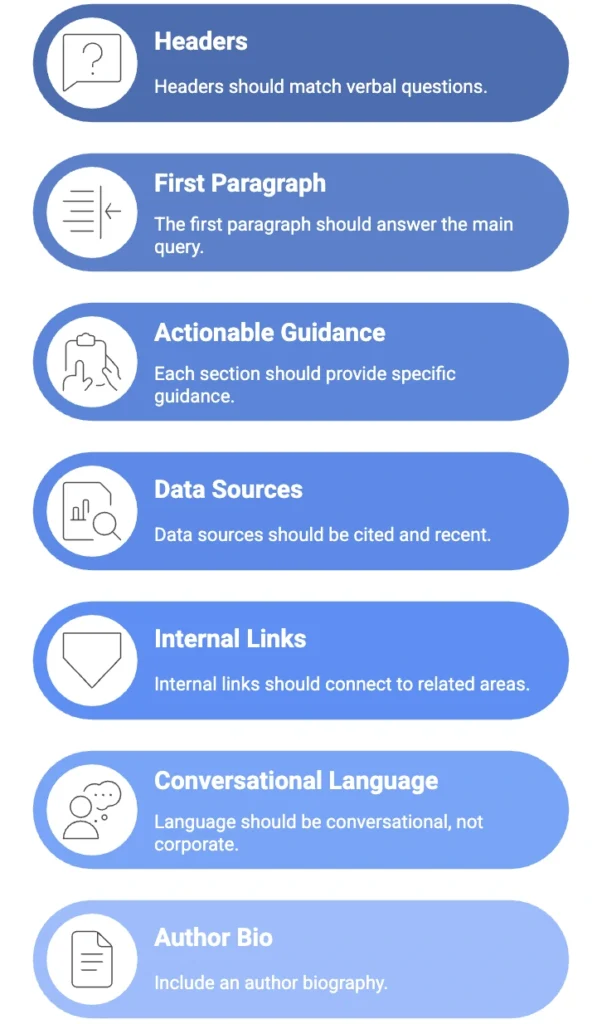Your startup’s content strategy needs to evolve fast. While you’ve been perfecting your SEO game for Google, your potential customers are increasingly turning to ChatGPT, Perplexity, and Google’s AI Overviews for answers. The solution? Generative Engine Optimization (GEO) the practice of optimizing content so AI models cite and reference your brand when answering user queries.
Here’s your complete tactical playbook to dominate AI search in your niche, with specific scripts, templates, and implementation steps you can execute starting today.
What is GEO and why startups can’t ignore it
Traditional search was built on links; GEO is built on language. When someone asks ChatGPT “What’s the best CRM for startups?” you want your product mentioned in that conversational answer, not buried on page two of Google results.
The difference is stark: SEO optimizes for clicks, GEO optimizes for citations. And those citations are becoming the new currency of digital discovery.
Step 1: Conduct your complete GEO audit
Before optimizing anything, you need a baseline. Here’s your exact audit process:
Phase 1: Query Testing
Test these specific query types across ChatGPT, Claude, Perplexity, and Google’s AI Overviews:
Direct competitor queries:
- “Best [your product category] for [your target market]”
- “Top alternatives to [major competitor]”
- “[Competitor name] vs alternatives”
Problem-solving queries:
- “How to solve [primary problem you address]”
- “What causes [pain point] in [industry]”
- “Steps to [desired outcome your product enables]”
Educational queries:
- “What is [key concept in your space]”
- “How does [your category] work”
- “Guide to [process you help with]”
Phase 2: Documentation Template
Create a spreadsheet with these columns:
- Query
- AI Platform
- Your Brand Mentioned? (Y/N)
- Position if mentioned (1st, 2nd, etc.)
- Competitors mentioned
- Context of mention
- Factual accuracy
Phase 3: Gap Analysis
Red flags to identify:
- Zero mentions across 20+ relevant queries
- Competitors consistently cited while you’re invisible
- Inaccurate information about your company/product
- Missing from educational content where you have expertise
Reddit insight on r/marketing: “Did a GEO audit and realized we weren’t mentioned in AI responses for our core use case, despite ranking #1 on Google for the same keywords. Total wake-up call.”
Step 2: Map your GEO content strategy
Based on your audit, create your content roadmap using this framework:
The Authority Stack Method
Tier 1: Foundation content (Must-have)
- Ultimate guide to your core topic
- Definitive comparison of solutions in your space
- Industry report with original data
- FAQ resource addressing all common questions
Tier 2: Supporting content (Should-have)
- Implementation guides for each major use case
- Troubleshooting guides for common problems
- Best practices from customer success stories
- Integration tutorials for popular tools
Tier 3: Expansion content (Nice-to-have)
- Industry trend analysis
- Expert interview series
- Case study deep-dives
- Tool comparisons beyond your direct competitors
Content Priority Matrix
Plot each content idea on:
- X-axis: Current AI mention frequency for this topic (0-10)
- Y-axis: Business impact if you dominated this topic (0-10)
Focus first on high-impact, low-competition topics (bottom-right quadrant).
Step 3: Create your first GEO-optimized pillar page
Here’s your exact template for creating citation-worthy content:
Title Formula
“The Complete [Year] Guide to [Topic]: [Specific Outcome] for [Target Audience]”
Example: “The Complete 2025 Guide to Email Marketing Automation: Reducing CAC by 40% for SaaS Startups”
Required Content Structure
Opening section (300 words):
- Direct answer to main question in first paragraph
- Overview of what readers will learn
- Context on why this matters now
- Your credentials/experience statement
Main content sections (8-12 sections, 400-600 words each):
- H2 headers that mirror natural speech patterns
- Lead with the key takeaway in each section
- Include specific data, examples, or case studies
- End with actionable next steps
Supporting elements:
- Comparison tables with 5+ options
- Step-by-step processes with numbered lists
- Screenshots or diagrams where helpful
- FAQ section answering 10-15 common questions
GEO Onsite Optimization Checklist
Although this overlaps with SEO best onsite practices. but before publishing, verify:
- Headers match how people ask questions verbally
- First paragraph directly answers the main query
- Each section provides specific, actionable guidance
- Data sources are cited and recent (within 12 months)
- Internal links connect to related expertise areas
- Content length exceeds 2,500 words for pillar pages
- Language is conversational, not corporate
- Technical terms are defined in context
- Have Author Bio

Step 4: Implement conversation-optimized language patterns
Transform your existing content using these specific techniques:
Before/After Language Optimization
| Instead of | Write |
| “Our methodology leverages advanced algorithms” | “Here’s how we help startups reduce customer acquisition costs by 40%” |
| “Key considerations include…” | “The three things most founders miss when choosing…” |
| “Implementation involves multiple phases” | “Here’s exactly how to set this up in 5 steps” |
Question-Answer Content Blocks
For every major topic, include these question patterns:
- “What is [concept] and why does it matter for [audience]?”
- “When should [audience] consider [solution/approach]?”
- “How much does [solution] typically cost for [specific use case]?”
- “What’s the difference between [option A] and [option B]?”
- “How do you know if [approach] is working?”
Natural Transition Phrases
Use these to improve flow and AI comprehension:
- “Here’s why that matters…”
- “The key insight most people miss…”
- “What we’ve learned from 100+ implementations…”
- “The mistake that kills 80% of attempts…”
- “Here’s the specific approach that works…”
Step 5: Build topical authority with content clusters
Create comprehensive topic clusters using this systematic approach:
Hub-and-Spoke Model
Central hub: Your main pillar page (from Step 3)
Supporting spokes: 8-12 related pieces covering specific aspects
Content Cluster Planning Template
Main topic: [Your core expertise area]
Cluster content outline:
- Beginner’s guide: “Getting started with [topic]”
- Advanced strategies: “Advanced [topic] techniques for [audience]”
- Tool comparison: “Best tools for [specific use case]”
- Implementation guide: “Step-by-step [process] setup”
- Troubleshooting: “Common [topic] problems and solutions”
- Case studies: “How [customer type] achieved [outcome]”
- Integration guide: “Connecting [topic] with [related tools]”
- ROI analysis: “Measuring [topic] success and ROI”
Internal Linking Strategy
- Link from hub to all spokes using descriptive anchor text
- Cross-link related spokes when contextually relevant
- Use breadcrumb navigation showing content relationships
- Create topic-based resource pages linking to clusters
Reddit insight on r/SEO: “Started getting mentioned by AI tools way more after we published a complete content series instead of random posts. They seem to understand we actually know the topic inside and out.”
Step 6: Technical optimization for AI parsing
Implement these technical elements to improve AI content consumption:
Schema Markup Implementation
Add these schema types to relevant pages:
Article schema (for blog posts):
{
"@type": "Article",
"headline": "Your article title",
"author": {
"@type": "Person",
"name": "Author name"
},
"datePublished": "2025-XX-XX",
"publisher": {
"@type": "Organization",
"name": "Your company"
}
}
FAQ schema (for question sections):
{
"@type": "FAQPage",
"mainEntity": [{
"@type": "Question",
"name": "Question text",
"acceptedAnswer": {
"@type": "Answer",
"text": "Answer text"
}
}]
}
Content Structure Optimization
Header hierarchy:
- H1: Main topic (only one per page)
- H2: Major sections answering specific questions
- H3: Subsections with detailed explanations
- H4: Specific steps or examples
Paragraph structure:
- Maximum 3-4 sentences per paragraph
- Lead with key takeaway in each paragraph
- Use transition sentences between paragraphs
- Break up long explanations with subheaders
Meta Information
Title tags: Include target audience and specific outcome Meta descriptions: State expertise and key benefit clearly Alt text: Describe images in context of surrounding content
Step 7: Create your GEO measurement system
Track your progress with this comprehensive monitoring approach:
Weekly Citation Tracking
Manual testing routine:
- Test 10 core queries across 4 AI platforms
- Document position and context of any mentions
- Note new competitors appearing in results
- Track changes in mention frequency
Tracking spreadsheet columns:
- Date
- Query
- Platform
- Mentioned? (Y/N)
- Position
- Context quality (1-5)
- Competitors mentioned
- Notes
Monthly Comprehensive Analysis
Metrics to calculate:
- Citation rate: (Queries where you’re mentioned / Total relevant queries tested) × 100
- Average position when mentioned
- Share of voice vs. competitors
- New query opportunities identified
Traffic attribution tracking:
- Set up UTM parameters for AI-driven traffic
- Monitor brand search volume increases
- Track “direct” traffic spikes correlating with citation improvements
- Survey new customers about discovery methods
GEO Performance Dashboard
Create a simple dashboard tracking:
- Monthly citation rate trend
- Top 5 queries where you appear
- Competitor mention frequency
- Content performance by format
Step 8: Scale content production with AI agents
Once you’ve proven the system works, scale efficiently:
Content Production Workflow
Research and planning
- Use AI to identify content gaps in your niche
- Generate comprehensive topic outlines
- Research competitor content for improvement opportunities
Content creation
- AI creates detailed first drafts following your templates
- Human experts add specific insights, data, and examples
- Review and optimize for GEO elements
Publishing and promotion
- Publish with proper technical optimization
- Update existing content with internal links
- Share insights across relevant channels
Quality Control Checklist
Before publishing AI-assisted content:
- Includes specific, actionable advice
- Contains original insights or data
- Uses conversational, expert language
- Follows GEO structure template
- Links strategically to related content
- Provides genuine value beyond existing resources
Advanced GEO tactics for competitive niches
Content Differentiation Strategies
Original research approach:
- Survey your customer base for unique insights
- Analyze usage data for trend identification
- Compile industry benchmarks from your experience
Expert perspective injection:
- Include quotes from recognized industry experts
- Reference exclusive interviews or conversations
- Share behind-the-scenes insights from your industry involvement
Data-driven content:
- Use your product data to inform content
- Cite specific customer outcomes and metrics
- Reference A/B testing results from your implementations
Competitive Intelligence
Monitor competitor GEO performance:
- Track their citation frequency for shared keywords
- Identify content gaps they haven’t addressed
- Note their content formats and structures
- Learn from their successful approaches while differentiating
Content opportunity identification:
- Find queries where competitors appear but provide incomplete answers
- Identify emerging topics with low competition
- Discover adjacent niches where your expertise applies
Common GEO implementation pitfalls to avoid
Pitfall #1: Keyword-stuffing mindset GEO isn’t about keyword density. Focus on comprehensive topic coverage and natural language patterns.
Pitfall #2: Surface-level content AI engines favor depth. A 800-word blog post rarely gets cited over a 3,000-word comprehensive guide.
Pitfall #3: Ignoring user intent Write for the actual questions people ask AI, not just search volume keywords.
Pitfall #4: Inconsistent publishing Sporadic content creation won’t build the topical authority needed for consistent citations.
Pitfall #5: Neglecting content updates Outdated information gets cited less frequently. Refresh content quarterly with new data and insights.
